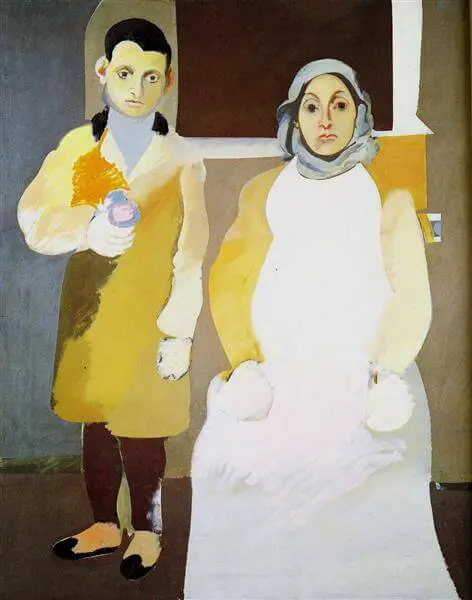Title of Artwork: “The Artist and His Mother”

Artwork by Arshile Gorky
Year Created 1926-1936
Summary of The Artist and His Mother
The Artist and His Mother (1926-1936) is Arshile Gorky’s pinnacle of figurative paintings. It is based on a photograph of the painter and his mother taken in Armenia in 1912. Only three years later, the Ottoman Empire launched the Armenian Genocide, a systematic extermination of the Armenian people. Despite the fact that Gorky and his family survived a death march, the ordeal left them permanently scarred. His mother’s health suffered the most, and she died of malnourishment in 1919.
Gorky began working on the double portrait in 1926 and completed it over the next decade. Gorky made a lot of preparatory sketches and studies during this time. Two quick pen sketches, for example, were used to set up the composition and arrangement of the painting. In another pencil sketch, the artist created a detailed study for the painting by enlarging the drawing with a grid of numbered squares. He also created a warmer colour palette version of The Artist and His Mother (ca.1926-1942). Nonetheless, the painterly treatment and finishing touches on this version do not appear to be as sharp and precise.
All About The Artist and His Mother by Arshile Gorky
Gorky applied and scraped thin layers in The Artist and His Mother to create the soft glow of marble or porcelain. He painted stiff figures in cool, muted colours, blending ochre, blue, green, and brown patches. The mother’s figure resembles a statue due to her severe posture and the flat surface of her apron, which resembles a smooth piece of marble or stone. The Artist and His Mother was influenced stylistically by Pablo Picasso’s works, particularly the painting Portrait of Gertrude Stein (1906). The artist paid close attention to the eyes in this and other portraits, such as Portrait of Vartoosh (1936-1937). Gorky saw expressive eyes as typical Armenian characteristics. He may have seen mediaeval religious paintings and manuscripts highlighting these features as a child in his native village. Gorky later discovered Russian icons in American museums, as well as large eyes in Sumerian and Hittite art, which he associated with his Caucasian ancestors.
The Artist and His Mother depicts the horrific events that shaped Gorky’s early life, as well as the traumatic loss of his mother. Gorky chose to leave parts of the scene unfinished when painting the scene. He added a sense of violence to the painting by erasing his mother’s two hands. Gorky’s figures, particularly his mother, appear to disintegrate in the same way that memories become more elusive with time. Gorky transformed the old photograph into a mental introspection: on the canvas, he reconstructed the photograph’s complex emotional response. The mother’s statue-like figure, hollow eyes, and numb expression make her appear almost ghost-like. In comparison, the young boy’s figure has three dimensions and a distinct sad expression. The painting was an expression of personal loss for Gorky, and it became a symbol of the tragedy of the Armenian Genocide for many others.
























